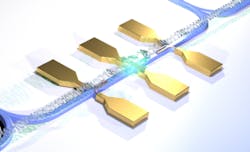KIT first to complete quantum circuit with electrically driven CNT light source
For the first time, scientists from Germany, Poland, and Russia under the leadership of professors Wolfram Pernice of the Westphalian Wilhelm University of Münster (WWU) and Ralph Krupke, Manfred Kappes, and Carsten Rockstuhl of the Karlsruhe Institute of Technology (KIT) in Germany have succeeded in placing a complete quantum optical structure on a chip towards the realization of an optical quantum computer, as described in Nature Photonics (DOI: 10.1038/nphoton.2016.178).
RELATED ARTICLE: Quantum computing gets boost from MIT on-chip single-photon arrays
"Experiments investigating the applicability of optical quantum technology so far have often claimed whole laboratory spaces," explains professor Ralph Krupke of the KIT. "However, if this technology is to be employed meaningfully, it must be accommodated on a minimum of space." The light source for the quantum photonic circuit used by the scientists for the first time was special nanotubes made of carbon. They have a diameter 100,000 times smaller than a human hair, and they emit single light particles when excited by laser light. Light particles (photons) are also referred to as light quanta, hence the term "quantum photonics."
That carbon nanotubes emit single photons makes them attractive as ultracompact light sources for optical quantum computers. "However, it is not easily possible to accommodate the laser technology on a scalable chip," admits physicist Wolfram Pernice. The scalability of a system, i.e. the possibility to miniaturize components so as to be able to increase their number, is a precondition for this technology to be used in powerful computers up to an optical quantum computer.
As all elements on the chip now developed are triggered electrically, no additional laser systems are required any more, which is a marked simplification over the optical excitation normally used. The scientists studied whether the flow of electricity through carbon nanotubes caused single light quanta to be emitted. For this purpose, they used carbon nanotubes as single-photon sources, superconducting nanowires as detectors, and nanophotonic waveguides. One single-photon source and two detectors each were connected with one waveguide. The structure was cooled with liquid helium to allow single light quanta to be counted. The chips were produced in an electron beam scribing device.
The scientists' work is fundamental research. It is not yet clear whether and when it will lead to practical applications. Wolfram Pernice and the first author, Svetlana Khasminskaya, were supported by the Deutsche Forschungsgemeinschaft and the Helmholtz-Gemeinschaft, Ralph Krupke was funded by the Volkswagen Foundation.
SOURCE: Karlsruhe Institute of Technology; http://www.kit.edu/kit/english/pi_2016_132_first-quantum-photonic-circuit-with-an-electrically-driven-light-source.php

Gail Overton | Senior Editor (2004-2020)
Gail has more than 30 years of engineering, marketing, product management, and editorial experience in the photonics and optical communications industry. Before joining the staff at Laser Focus World in 2004, she held many product management and product marketing roles in the fiber-optics industry, most notably at Hughes (El Segundo, CA), GTE Labs (Waltham, MA), Corning (Corning, NY), Photon Kinetics (Beaverton, OR), and Newport Corporation (Irvine, CA). During her marketing career, Gail published articles in WDM Solutions and Sensors magazine and traveled internationally to conduct product and sales training. Gail received her BS degree in physics, with an emphasis in optics, from San Diego State University in San Diego, CA in May 1986.
